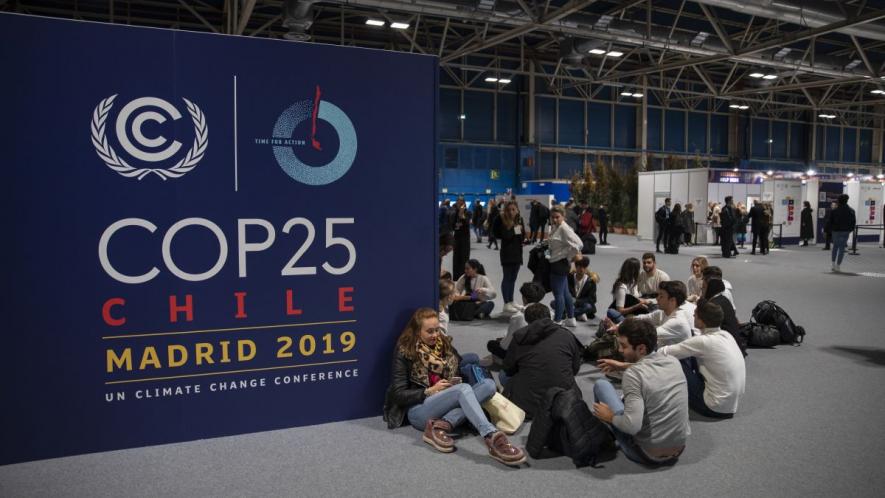Story of COP25: Climate Ambition in the Face of Climate Inaction

With the 25th Conference of Parties (COP25) to the UNFCCC ending without any result, there are some strong lessons for all those who gave up fighting for equity and climate justice citing the “political infeasibility” of operationalising these principles. It is also a lesson to those who celebrated a weak agreement at Paris that was devoid of equity because it was better than “no agreement”. Allowing developed countries to exclude historical responsibility in Paris is now likely to lead to the erasure of any responsibility at all.
Increasing pressure on India and China seems to be name of the game, with these two large developing countries being demonised already, despite the fact that the United States -- the highest emitter of CO2 so far -- has begun the process of withdrawing from the Paris Agreement, and other developed countries are far from achieving even the inadequate targets they set for themselves.
The inaction of developed countries in the 27 years since the Rio conference is now evident. The numbers clearly show that emissions from the richest countries have reduced only marginally, to be precise by only 1.6% in 2017 as compared to emissions in 1990.
Developing countries spent the past two weeks in Madrid (the venue of COP25) fighting to ensure that the mitigation burden resulting from this inaction of the rich countries was not transferred to the poor countries. While this year’s conference has been characterised by the rhetoric of high climate ambition, the actual state of affairs in terms of implementing climate action is dismally inadequate and inequitable.
Climate change received a lot of attention in 2019, both in the First and Third World, as youth movements calling for urgent and ambitious climate action organised climate strikes and protests that received significant media coverage. COP 25 in Madrid also resonated with the presence of these youth movements and the COP President herself referred multiple times to calls made by young people for ambitious actions from world leaders.
This year is also the last one before the Paris Agreement comes into effect in 2020. The Paris Agreement, which includes climate contributions pledged by all countries and not just the developed ones, was signed based on the solemn promise of the rich countries that they would meet their commitments to reduce emissions by 2020. However, these commitments have not only not been honoured, there has also been a concerted effort to ensure that the rich countries are not held accountable for reneging on their promises.
The 4th Assessment Report of the IPCC 9 (Intergovernmental Panel on Climate Change) had stated that the Cancun pledges (made for 2020) were not enough to limit warming to 2 deg. C, let alone the more ambitious target of 1.5 deg. C, included in the Paris Agreement.
However, the developed countries are far from reaching even their own pledges. Additionally, the 5th Assessment Report of the IPCC decisively states that the cumulative emissions and not emission flows, are the correct measure for determining the mitigation requirement for limiting warming. In cumulative terms, the developed countries fare even worse.
First World scientists, governments, and civil society have been talking of ambitious action to limit warming to below 1.5 deg. C. The science shows that 2018 onwards, the world as a whole can emit only 480 giga tonnes of carbon equivalent (GtCO2 eq – the number includes all greenhouse gases). Between 1990 and 2017, the Annex-I parties to the UNFCCC, i.e. 45 developed countries alone, have emitted 784 GtCO2 eq (not including emissions from land use change and forestry).
If we exclude the economies in transition, i.e. the countries that were part of the former Soviet Union and experienced high levels of emissions reductions between 1991 and 2010 due to severe recession, then the non-EIT (Economies in Transition) developed countries together have emitted 390 GtCO2 between 1990 and 2017. These are the 28 richest countries in the world. They account for only 13% of the global population, but 58% of the global GDP. From 1990, these countries were obligated to reduce emissions and take the lead in climate change mitigation because these countries accounted for most of the emissions before 1990 and a large share of the global wealth was also concentrated there. However, despite agreeing to this as part of the United Nations Framework Convention on Climate Change (UNFCCC), these countries have continued to occupy a large share of the carbon budget even after 1990.
It is no secret anymore that the energy transition in these rich countries has not been one of coal-based energy to renewable energy, as required for climate change mitigation. These countries have instead transitioned marginally out of coal, but to another fossil fuel, namely natural gas. In the US for instance, natural gas consumption increased by 43% between 1990 and 2017 and by another 11% by 2018. A total of 14% of the primary energy consumption in the US still comes from coal, and the country has no plans of phasing out either its coal use or other fossil fuels. Natural gas and petroleum constituted 66% of the total primary energy consumed in the US, while solar and wind constituted a meagre 3%, in 2017.
Germany, widely considered a leader on climate change, has a per capita coal consumption of 2.62 tonnes/person (for some perspective, India’s per capita coal consumption is 0.73 tonnes/person). It has pushed back its plans to phase out coal to 2038 and has no plans of phasing out natural gas or oil, which still continue to be the mainstay of Germany’s energy consumption.
To make matters worse, Germany has not reduced it’s emissions by 40% between 1990 and 2020, as promised. By 2017, Germany’s emissions have reduced by only 28% and it is unlikely to make up the gap by next year as their emissions have stabilised since 2009. Germany installed only 6 GW of solar and wind energy in 2018. In contrast, India, a much poorer country (with a per capita GDP that is 23 times less than that of Germany’s) installed 12 GW of solar and wind-based power; double of what Germany achieved.
This is the story of the self-proclaimed best and the widely acknowledged worst amongst the rich countries, which provides ample evidence of the state of affairs. The six largest emitters– US, Japan, Germany, Canada, the United Kingdom and France – have cumulatively emitted 312 GtCO2 between 1990 and 2017. And they continue to emit more. They are now calling for all countries to increase ambition to avoid a “climate emergency”. Put this 312 GtCO2 of just these six countries in the context of the 480 GtCO2 that the world as a whole has left 2018 onwards for limiting temperature rise to below 1.5 deg. C, and the situation is clear.
The inaction of the developed world will impact the poorest populations within developing countries the most. And the agenda now is to shift the burden of doing something about the problem also to the very countries that house the poorest sections of the global population. COP25, with all its rhetoric on “climate ambition”, was really about asking developing countries to carry the burden of 150 years of First World privilege, and excuse its inaction of the past three decades when it was supposed to take the lead in saving the planet from climate change.
The writer is with the Energy Environment Programme, School of Natural Sciences and Engineering National Institute of Advanced Studies (NIAS), Bengaluru. The views are personal.
Get the latest reports & analysis with people's perspective on Protests, movements & deep analytical videos, discussions of the current affairs in your Telegram app. Subscribe to NewsClick's Telegram channel & get Real-Time updates on stories, as they get published on our website.























